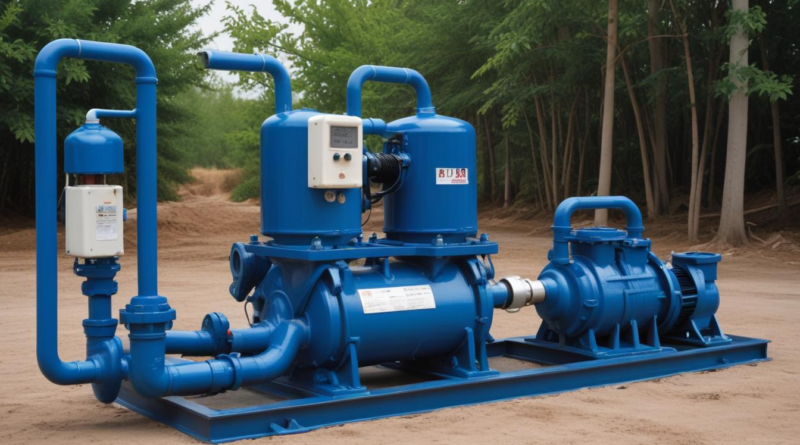how to choose a pump based on environmental factors
When selecting a pump, thoroughly evaluating the surrounding environmental conditions is essential to ensure optimal performance and longevity. Key considerations include:
- Temperature Range: Determine the operational temperature range the pump will be exposed to, as extreme temperatures can affect material integrity and pump efficiency.
- Humidity and Moisture Levels: High humidity or constant moisture can lead to corrosion and electrical issues, necessitating appropriate sealing and material choices.
- Presence of Corrosive Substances: Identify any corrosive chemicals or abrasive particles in the environment to select materials resistant to such conditions.
- Altitude: Operating at high altitudes may require adjustments in pump design to account for changes in atmospheric pressure.
- Vibration and Noise Levels: Assessing the environmental tolerance for noise and vibration can influence the type of pump and mounting options chosen.
A comprehensive assessment ensures that all relevant environmental factors are considered, aligning the pump’s performance with the specific criteria required for the application.
| Environmental Factor | Impact on Pump Selection | Considerations |
|---|---|---|
| Temperature | Material durability and seal performance | Select pumps with suitable materials and thermal ratings |
| Corrosive Agents | Corrosion resistance and lifespan | Use corrosion-resistant alloys or coatings |
| Moisture Levels | Electrical safety and component integrity | Implement proper sealing and insulation |
| Altitude | Operating efficiency and pressure requirements | Adjust pump specifications for altitude-related pressure changes |
| Noise and Vibration | Operational comfort and structural compatibility | Choose pumps with noise-reducing features and proper mounts |
By meticulously analyzing these aspects, the appropriate pump selection can be made to meet the environmental criteria effectively.
determining pump material suitability
Selecting the appropriate materials for a pump is crucial to ensure its performance and longevity in various environmental conditions. Material suitability directly impacts the pump’s resistance to corrosion, wear, and thermal stress, aligning with the specific criteria required for the application. Key considerations include:
- Corrosion Resistance: Pumps exposed to corrosive fluids or environments require materials that can withstand chemical degradation. Stainless steel, titanium, and certain alloys are commonly used for their superior corrosion-resistant properties.
- Temperature Tolerance: The operating temperature range influences material selection. High-temperature applications may necessitate materials like carbon steel or specialized polymers that maintain integrity under thermal stress.
- Wear Resistance: In environments where the pumped fluid contains abrasive particles, materials with high hardness and durability, such as cast iron or hardened steel, are essential to minimize wear and extend pump life.
- Chemical Compatibility: Ensuring that pump materials are chemically compatible with the fluid being pumped prevents reactions that could compromise pump performance and safety.
- Mechanical Strength: The material must possess adequate mechanical strength to handle the pressures and stresses encountered during operation without deforming or failing.
A comprehensive understanding of these factors facilitates informed pump selection tailored to the specific environmental factors present. The table below outlines common pump materials, their advantages, and suitable applications:
| Material | Advantages | Suitable Applications |
|---|---|---|
| Stainless Steel | Excellent corrosion resistance, high strength, durability | Chemical processing, marine environments, food and beverage industry |
| Cast Iron | Good wear resistance, cost-effective, robust | Water supply systems, sewage treatment, industrial cooling |
| Brass/Bronze | Good resistance to seawater corrosion, machinable | Marine applications, HVAC systems, decorative fixtures |
| Plastics (e.g., PVC, HDPE) | Lightweight, corrosion-resistant, easy to manufacture | Irrigation systems, pool pumps, non-corrosive fluids |
| Titanium | Exceptional corrosion resistance, high strength-to-weight ratio | Aerospace, chemical processing, high-performance applications |
| Carbon Steel | High strength, good thermal conductivity | High-temperature applications, oil and gas industry |
Additionally, selecting the right materials involves evaluating the compatibility between different pump components. For instance, seals and gaskets must be made from materials that can withstand the chemical and thermal conditions without degrading. The integration of dissimilar materials should also be carefully managed to prevent galvanic corrosion, which can occur when two different metals are in electrical contact in the presence of an electrolyte.
Environmental factors such as exposure to ultraviolet light, humidity, and physical abrasion further dictate material choices. For outdoor installations, UV-resistant materials and protective coatings may be necessary to prevent degradation from sunlight. In high-humidity environments, materials with low moisture absorption rates help maintain pump integrity and performance.
Ultimately, a meticulous assessment of material properties in relation to the specific operating environment ensures that the selected pump not only meets the immediate performance requirements but also offers sustainable, long-term reliability. By prioritizing material suitability, the overall efficiency and durability of the pump system are significantly enhanced, aligning with the essential criteria for successful pump deployment.
evaluating energy efficiency
Energy efficiency is a critical aspect of pump selection, particularly in applications where energy consumption significantly impacts operational costs and environmental sustainability. Evaluating the energy efficiency of a pump involves analyzing several key factors that contribute to overall performance and cost-effectiveness. Key considerations include:
- Efficiency Ratings: Pumps are rated based on their hydraulic and motor efficiency. High-efficiency pumps convert more electrical energy into hydraulic energy, reducing energy wastage and operational costs.
- System Curve Alignment: Ensuring that the pump’s performance curve aligns with the system’s demand curve maximizes efficiency. Misalignment can lead to excessive energy use and reduced pump lifespan.
- Variable Speed Drives (VSDs): Incorporating VSDs allows for real-time adjustments to the pump’s operating speed, enhancing energy savings by matching pump output to actual demand.
- Flow Rate and Head Requirements: Selecting a pump that closely matches the required flow rate and head minimizes energy consumption by avoiding over-sizing or under-sizing.
- Operating Hours: Understanding the pump’s duty cycle can influence energy efficiency strategies. Pumps operating continuously benefit more from high-efficiency designs and VSDs.
By carefully assessing these factors, organizations can select pumps that not only meet their operational needs but also contribute to significant energy savings and reduced environmental impact. The following table outlines common energy efficiency metrics and their implications for pump selection:
| Energy Efficiency Metric | Description | Implications for Pump Selection |
|---|---|---|
| Ceiling Efficiency | The maximum theoretical efficiency of a pump at a given flow and head | Helps identify pumps with the highest potential efficiency for specific applications |
| System Efficiency | The actual efficiency of the pump within the system, considering all losses | Provides a realistic assessment of energy consumption and identifies improvement areas |
| Energy Use Index (EUI) | A measure of the energy consumed by the pump per unit of flow | Facilitates comparisons between different pump models and manufacturers |
| Motor Efficiency | The efficiency of the pump’s motor in converting electrical power to mechanical power | Higher motor efficiency reduces overall energy consumption and operating costs |
| Power Factor | The ratio of real power used to do work to apparent power supplied to the system | Improving power factor can lead to lower electricity costs and reduced demand charges |
Implementing energy-efficient pump solutions can also involve leveraging advanced technologies and best practices:
- Regular Maintenance: Ensuring that pumps are well-maintained prevents energy losses due to wear, fouling, or inefficient operation.
- Advanced Control Systems: Utilizing smart controls and automation can optimize pump performance and energy usage based on real-time demand.
- High-Efficiency Motors: Selecting motors with higher efficiency ratings, such as premium efficiency or IE3 motors, can lead to substantial energy savings.
- Proper Sizing: Accurately sizing pumps to match system requirements avoids the inefficiencies associated with oversized or undersized equipment.
- Energy Audits: Conducting comprehensive energy audits can identify inefficiencies within the pump system and provide recommendations for improvement.
Incorporating these strategies ensures that the selected pump not only meets the operational criteria but also aligns with sustainability goals by minimizing energy consumption and reducing the overall carbon footprint. By prioritizing energy efficiency during pump selection, organizations can achieve long-term cost savings and contribute to environmental preservation, reinforcing the importance of comprehensive pump selection processes that consider all relevant environmental factors.
considering installation location
 When determining the optimal placement for a pump, the installation location plays a pivotal role in ensuring both operational efficiency and ease of maintenance. Various factors related to the physical setting can significantly influence pump selection and overall system performance. Key considerations include:
When determining the optimal placement for a pump, the installation location plays a pivotal role in ensuring both operational efficiency and ease of maintenance. Various factors related to the physical setting can significantly influence pump selection and overall system performance. Key considerations include:
- Space Availability: Assess the dimensions of the installation site to ensure that the pump fits comfortably, allowing for proper ventilation and access for maintenance. Tight spaces may necessitate compact pump models or alternative configurations.
- Environmental Exposure: Determine whether the pump will be installed indoors or outdoors. Outdoor installations require pumps that can withstand weather elements, such as rain, dust, and temperature fluctuations, often necessitating weatherproof enclosures or protective coatings.
- Accessibility: Ensure that the pump is easily accessible for routine inspections, maintenance, and potential repairs. Adequate space around the pump facilitates quick access and minimizes downtime during servicing.
- Noise Considerations: In settings where noise levels must be minimized, such as residential areas or office buildings, selecting a pump with low noise emissions or incorporating sound-dampening measures is essential.
- Ventilation and Cooling: Proper airflow is critical for maintaining optimal pump temperatures and preventing overheating. Installations in confined or poorly ventilated areas may require additional cooling solutions or fans.
- Proximity to Power Sources: Position the pump near reliable power sources to reduce the complexity and cost of electrical installations. Additionally, ensure that power supply requirements match the pump’s specifications to prevent electrical issues.
- Integration with Existing Systems: Consider how the pump will connect with existing pipelines, control systems, and other infrastructure. Compatibility with current setups can streamline installation and reduce modifications.
- Safety and Compliance: Adhere to local building codes and safety regulations when selecting the installation location. Proper placement ensures compliance and enhances the safety of both the equipment and personnel.
A comprehensive evaluation of these factors can be facilitated through the following table, which outlines the primary location-related considerations and their impact on pump selection:
| Location Factor | Impact on Pump Selection | Considerations |
|---|---|---|
| Space Constraints | Determines pump size and configuration | Select compact or modular pumps for limited spaces |
| Environmental Exposure | Influences material and protective features | Choose weatherproof or corrosion-resistant pumps for outdoor use |
| Accessibility | Affects maintenance and operational efficiency | Ensure ample space for access around the pump |
| Noise Levels | Impacts suitability for noise-sensitive areas | Select low-noise pumps or implement noise reduction strategies |
| Ventilation Requirements | Ensures optimal cooling and pump performance | Install in well-ventilated areas or provide additional cooling |
| Power Source Proximity | Reduces installation complexity and costs | Position near existing electrical infrastructure |
| System Integration | Facilitates seamless operation with existing systems | Ensure compatibility with current pipelines and controls |
| Safety Compliance | Ensures adherence to regulations and safe operation | Follow local codes and implement necessary safety measures |
Additionally, the following ordered list outlines best practices for optimizing pump installation location:
- Site Survey: Conduct a thorough survey of the proposed installation area to identify potential challenges and requirements.
- Environmental Protection: Implement measures such as weatherproof enclosures, drainage systems, and protective barriers to safeguard the pump from environmental hazards.
- Ergonomic Placement: Position the pump to facilitate easy access for operators, minimizing the need for cumbersome maneuvering during maintenance tasks.
- Vibration Isolation: Use vibration dampeners or mounts to reduce the transmission of vibrations to the surrounding structure, enhancing both pump longevity and structural integrity.
- Future Expansion: Plan for potential system expansions or upgrades by allocating additional space and considering modular pump designs that can be easily integrated into existing systems.
By meticulously evaluating the installation location, organizations can ensure that their pump systems are not only compatible with the physical environment but also adhere to operational criteria that enhance performance and reliability. This strategic approach to pump selection mitigates potential issues related to space, accessibility, and environmental exposure, ultimately contributing to a more efficient and sustainable pumping solution.
maintenance and durability factors
Ensuring proper maintenance and evaluating durability are pivotal aspects of pump selection, directly impacting the longevity and reliability of the pump system. These factors not only influence the initial investment but also affect long-term operational costs and system efficiency. Key considerations include:
- Ease of Maintenance: Pumps should be designed for easy access to critical components such as seals, bearings, and impellers. Features like modular construction and quick-release mechanisms facilitate routine maintenance and reduce downtime.
- Availability of Spare Parts: The accessibility of replacement parts ensures that repairs can be conducted promptly, minimizing operational disruptions. Selecting pumps from reputable manufacturers with readily available parts is essential for maintaining system reliability.
- Predictive Maintenance Capabilities: Incorporating sensors and monitoring systems allows for real-time tracking of pump performance and early detection of potential issues. This proactive approach helps in scheduling maintenance activities before major failures occur.
- Material Durability: The materials used in pump construction must withstand the operating environment and the nature of the pumped fluid. High-quality, durable materials reduce the frequency of repairs and extend the pump’s service life.
- Corrosion and Wear Resistance: Pumps operating in harsh environments or handling abrasive fluids require components that resist corrosion and wear. Enhanced resistance ensures sustained performance and reduces maintenance needs.
- Warranty and Support: Comprehensive warranties and robust technical support from manufacturers provide assurance against defects and offer assistance in troubleshooting issues, contributing to overall system durability.
A structured approach to maintenance and durability can be summarized in the following table:
| Factor | Impact on Pump System | Considerations |
|---|---|---|
| Maintenance Frequency | Determines operational downtime and labor costs | Select pumps with longer maintenance intervals and easy access to components |
| Spare Parts Availability | Affects repair time and system reliability | Choose pumps from manufacturers with a strong parts distribution network |
| Material Quality | Influences pump lifespan and resistance to environmental factors | Opt for high-grade materials suitable for the specific application |
| Corrosion Resistance | Prevents degradation and extends pump life | Use corrosion-resistant materials or protective coatings for aggressive environments |
| Wear Resistance | Reduces wear and tear from abrasive fluids | Implement hard-faced or treated components in contact with the fluid |
| Predictive Maintenance Tools | Enhances monitoring and early issue detection | Integrate sensors and monitoring systems for real-time data |
| Warranty and Support | Provides financial protection and technical assistance | Evaluate warranty terms and the quality of manufacturer support services |
Implementing effective maintenance strategies involves several best practices:
- Regular Inspection: Conduct routine inspections to identify signs of wear, corrosion, or damage. Early detection allows for timely interventions, preventing minor issues from escalating.
- Scheduled Maintenance: Establish a maintenance schedule based on the pump’s usage patterns and manufacturer recommendations. Systematic maintenance ensures consistent performance and extends the pump’s operational life.
- Training and Documentation: Ensure that maintenance personnel are well-trained and familiar with the pump’s components and maintenance procedures. Comprehensive documentation aids in efficient troubleshooting and repairs.
- Lubrication Management: Proper lubrication of moving parts reduces friction and wear, enhancing pump efficiency and longevity. Use appropriate lubricants as specified by the manufacturer.
- Environmental Protection: Protect pumps from environmental hazards such as dust, moisture, and extreme temperatures. Implementing protective measures like enclosures, weatherproofing, and cooling systems can mitigate adverse effects.
- Spare Parts Inventory: Maintain an inventory of essential spare parts to ensure quick replacements and minimize downtime during repairs.
- Performance Monitoring: Continuously monitor pump performance metrics such as flow rate, pressure, and energy consumption. Deviations from normal operating conditions can indicate potential maintenance needs.
By prioritizing maintenance and durability, organizations can ensure that their pump systems remain reliable and efficient over time. This strategic focus not only aligns with essential criteria for pump selection but also addresses critical environmental factors that influence the pump’s performance and lifespan. A well-maintained and durable pump system contributes to sustained operational excellence, reduced downtime, and lower total cost of ownership, making it a fundamental component of effective pump selection strategies.




